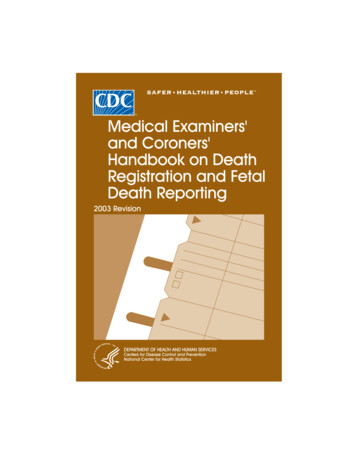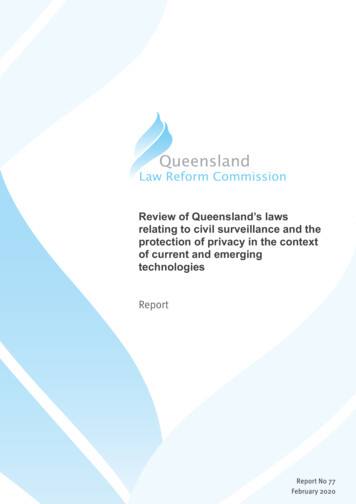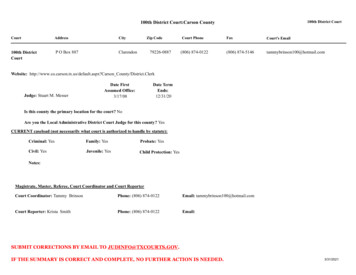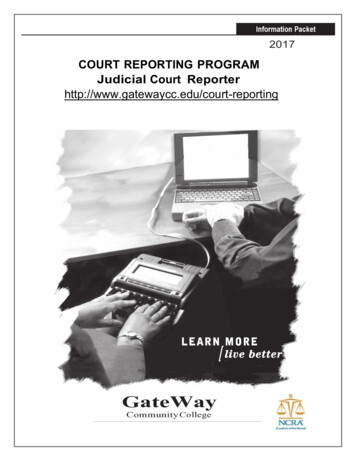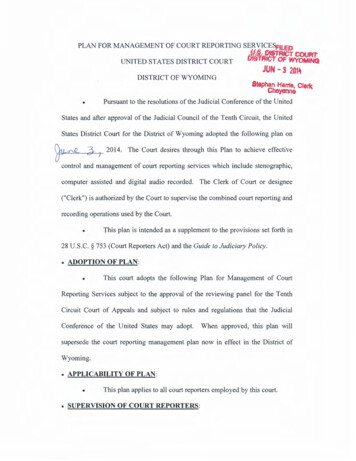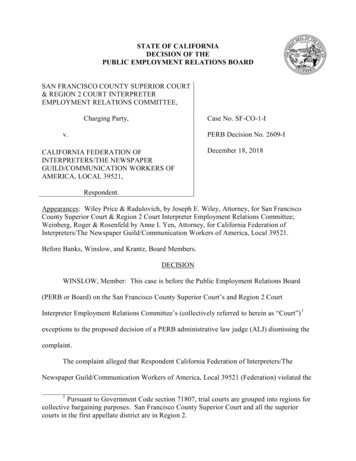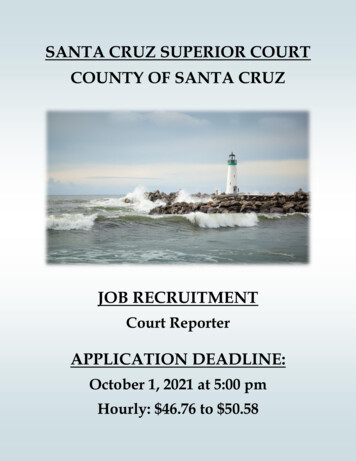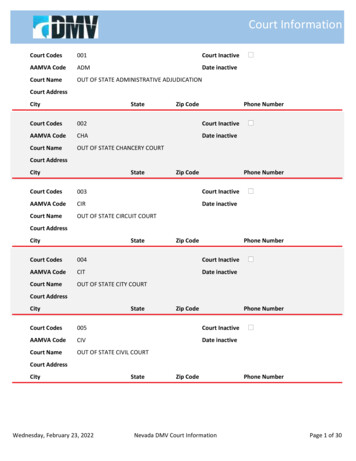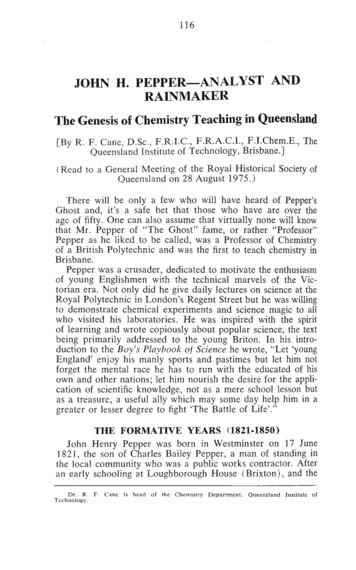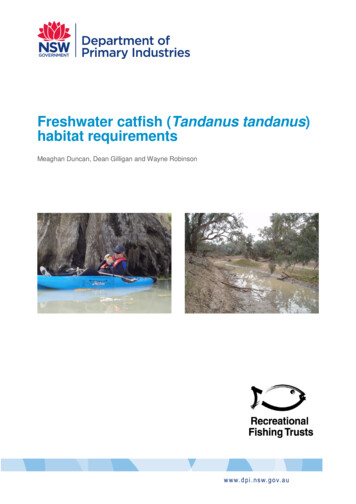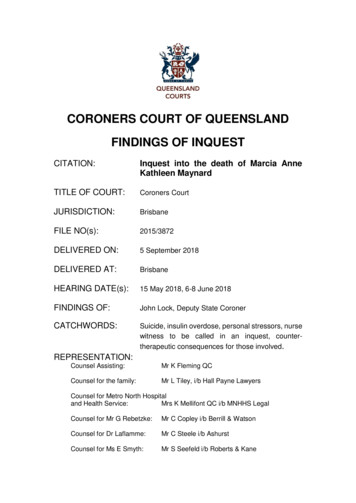
Transcription
CORONERS COURT OF QUEENSLANDFINDINGS OF INQUESTCITATION:Inquest into the death of Marcia AnneKathleen MaynardTITLE OF COURT:Coroners CourtJURISDICTION:BrisbaneFILE NO(s):2015/3872DELIVERED ON:5 September 2018DELIVERED AT:BrisbaneHEARING DATE(s):15 May 2018, 6-8 June 2018FINDINGS OF:John Lock, Deputy State CoronerCATCHWORDS:Suicide, insulin overdose, personal stressors, nursewitness to be called in an inquest, countertherapeutic consequences for those involved.REPRESENTATION:Counsel Assisting:Mr K Fleming QCCounsel for the family:Mr L Tiley, i/b Hall Payne LawyersCounsel for Metro North Hospitaland Health Service:Mrs K Mellifont QC i/b MNHHS LegalCounsel for Mr G Rebetzke:Mr C Copley i/b Berrill & WatsonCounsel for Dr Laflamme:Mr C Steele i/b AshurstCounsel for Ms E Smyth:Mr S Seefeld i/b Roberts & Kane
ContentsIntroduction . 1The issues . 2Cause of Death . 2Autopsy results . 2Report of Dr Michael Robertson . 3Investigations about the circumstances surrounding the death . 4Queensland Police Service Investigation . 4Workplace Health and Safety Queensland Investigation . 5Insulin and the workplace . 7What factors or stressors combined or contributed to cause her death . 8Physical and Mental Health Issues. 8Weight Loss. 8Employee Assistance Scheme counselling . 9Woodford Correctional Centre . 10Euthanasia . 11Relationship with Husband and family . 11Requirement to give evidence . 12Meeting with solicitor and barrister . 13Changing Will and Enduring Power of Attorney . 15Mrs Maynard’s professional reputation and the finding at the Mickeloinquest . 15Conclusions on the issues . 16Findings required by s. 45 . 20Identity of the deceased . 20How she died . 20Place of death . 20Date of death . 20Cause of death . 20Comments and recommendations . 20
Introduction1.Marcia Maynard died on 3 October 2015. Sometime between 29 September2015 and 30 September 2015, she self-administered a lethal dose of insulin. Shehad booked a room at a hotel and attended there on 29 September and wasfound unconscious in bed by hotel staff on 30 September.2.The Queensland Ambulance Service was called and it was noted by them thather blood sugar level was low. No drugs or drug paraphernalia were found byQAS staff on a search of the room. Mrs Maynard was taken to Redcliffe Hospitalwhere she remained unconscious and her condition continued to deteriorate.She died on 3 October 2015.3.Mrs Maynard was a registered nurse who was employed by Offender HealthServices at the Woodford Correctional Centre (Woodford). Woodford generalhealth care was provided by nursing staff and visiting medical officers (VMO)employed by Metro North Hospital and Health Service (Metro North), throughCaboolture Hospital, as part of the Offender Health Service (OHS).4.Mrs Maynard had provided nursing services to a prisoner, Garnet Mickelo, whodied on 24 November 2012.5.As Mr Mickelo died in custody, it was mandatory that an inquest into thecircumstances of his death be held.6.Mrs Maynard had provided a statement to the investigating State Coroner andan inquest was listed to commence on 7 October 2015. Mrs Maynard wasadvised she was to attend the inquest as a witness.7.Mrs Maynard was being represented by lawyers engaged by the QueenslandNurses Union. A barrister was also engaged and Mrs Maynard attended aconference with the instructing lawyer and counsel on 1 September 2015.8.Mrs Maynard wrote a letter dated 29 September 2015 to Miss Emily Cooper,counsel assisting in the coronial inquest. The letter appears to have been writtenin the context of her completing a further statement for the inquest, which mayhave contained material left out in an earlier statement. As Mrs Maynard statedin her letter, I now have been told they are gunning for me. She went on to say,again I am sorry but am unable to take the stress of trying to answer any more.9.Mrs Maynard also sent or left letters for her lawyers, daughter and her husbandindicating that a considerable stressor for her was related to the comment, theyare gunning for you; giving evidence at the inquest; as well as a general commentabout the stress of her workplace.10.The inquest in respect of the death of Mr Mickelo was adjourned and transferredto me as the Deputy State Coroner and held on other dates.11.The circumstances of the death of Mrs Maynard were investigated by theQueensland Police Service. Issues concerning the possible stressors existing ather workplace were referred to Workplace Health and Safety Queensland forinvestigation.Findings of the inquest into the death of Marcia Anne Kathleen MaynardPage 1 of 22
The issues12.13.Mrs Maynard’s family requested an inquest be held. A decision was made to holdan inquest and a pre-hearing conference held on 15 May 2018 determined theissues for the inquest as follows:i.The findings required by s. 45 (2) of the Coroners Act 2003; namelythe identity of the deceased, when, where and how she died andwhat caused her death.ii.The circumstances surrounding the death and what factors orstressors combined or contributed to cause her death.iii.Whether there are any matters about which preventativerecommendations might be made pursuant to section 46 of theCoroners Act 2003.The following witnesses were called to give evidence:a.b.c.d.e.f.g.h.i.j.k.l.m.n.o.Plain Clothes Senior Constable Edward Rogers – InvestigatingOfficerCraig Servin – Workplace Health & Safety Queensland InvestigatorMichael Maynard – husbandAnn Clayton – director at Caboolture Hospital responsible for staffingthe corrections health centreChristine Evans – work colleague of Mrs MaynardWarren Hann – work colleague of Mrs MaynardDean Izzard – work colleague of Mrs MaynardSushiela Kander – work colleague of Mrs MaynardCarolyn Manning – work colleague of Mrs MaynardMartha Pitt – Nurse Unit Manager, Woodford Correctional CentreDr Sebastien Laflamme – Mrs Maynard’s GPVictor-David Murray – Solicitor, prepared Mrs Maynard’s willEvonne Smyth – SolicitorGavin Rebetzke – Barrister-at-LawAnn-Marie Warren – PsychologistCause of deathAutopsy results14.As there were family objections to an internal examination, an externalexamination only was ordered. The external examination noted a number ofneedle puncture wounds on the front of the elbows, around the wrist, lowerabdomen and possibly around the right foot and ankle. The needle puncturewounds of the abdomen and some on the arms were consistent with injectingdrugs.15.There were no other significant external examination findings and CT scans wereunremarkable.16.The antemortem serum (1725 mU/L) and antemortem plasma insulin levels(2338 mU/L) were significantly high (normal range 2-23 mU/L). This was inkeeping with the history of insulin overdose however, it was not possible toFindings of the inquest into the death of Marcia Anne Kathleen MaynardPage 2 of 22
determine the accuracy of insulin levels due to metabolism of insulin during theearly antemortem period and production of endogenous insulin.17.The forensic pathologist, Dr Rohan Samarasinghe subsequently advised that themultiple injection marks could have occurred at the scene by QAS; at thehospital; as a result of self-infliction; or all three. Dr Samarasinghe stated apathologist cannot separate these injection marks individually (unless in somecases there is a significant period of time between producing each mark andwhere an internal examination of each of these wounds is performed). Injectionmarks can be subtle at times and can be easily overlooked. It is even difficult atpost-mortem due to post-mortem changes.18.Dr Samarasinghe stated that in living subjects injection marks can also appearlater with the tissue reaction progress. The abdomen is a very common sitewhere insulin is self-administered by patients.Report of Dr Michael Robertson19.Dr Michael Robertson is a pharmacologist and forensic toxicologist. DrRobertson was requested to provide an independent expert report, largely as aresult of the family concerns regarding the absence of insulin and injectingparaphernalia at the hotel room. This brought into question how quickly adverseeffects become apparent on overdose and whether it was possible for MrsMaynard to dispose of the drug and any utensils before she was overcome bythe effects of the insulin.20.Dr Robertson stated that insulin is a protein hormone consisting of twopolypeptide chains formed in and released from the pancreas in response toelevated glucose levels in the blood. An elevation of insulin facilitates themovement of glucose from the blood into the cells and thus results in a reductionof the circulating glucose levels assuming an absorption of glucose on thestomach is not occurring. This reduction in glucose levels may lead to a state ofhypoglycaemia.21.The adverse effects of hypoglycaemia may be mild and transient or moreprofound including death. The number and magnitude of adverse effects is basedon a number of factors such as dose, route of administration and formulation ofthe insulin administered.22.Elevated levels of insulin, either due to some natural pathology or theadministration of insulin, usually via subcutaneous injection, may result in aprogression of adverse effects that can include hypoglycaemia, hunger, fatigue,loss of concentration, nervousness, nausea, chills and sweats, tachycardia,seizures, shallow breathing, hypotension, coma and death.23.The most susceptible part of the body to insulin-mediated hypoglycaemia is thebrain and central nervous system more generally.24.Dr Robertson was unable to determine from the available evidence with anyreasonable scientific reliability, the amount of insulin consumed. Dr Robertsonstated that the high insulin concentration in the antemortem plasma and the lowC-peptide content supports the conclusion that exogenous insulin wasadministered.Findings of the inquest into the death of Marcia Anne Kathleen MaynardPage 3 of 22
25.Dr Robertson stated that commercially made insulin may be administeredintravenously, intramuscularly and subcutaneously. Each of the routes ofadministration will have differing onsets of action with the intravenous most rapidand the intramuscular the slowest. Commercially made insulin is also formulatedas either rapid acting insulin or long acting insulin or a combination of both andas such the onset of action also varies depending on the formulation used.26.Dr Robertson stated that given these variables it may take between 15 minutesand 30 minutes for insulin to start to take effect depending on the route ofinjection and the formulation injected.27.Dr Robertson stated that when a long acting insulin is taken via intramuscularinjection, there can be delayed effects and the effects will not be as pronounced.Short acting insulin can also produce this delayed effect when injectedsubcutaneously or intramuscularly however, will act relatively quickly ifadministered intravenously.28.Dr Robertson stated that when taking an overdose, depending on the amount ofinsulin administered, the route of administration and the formulationadministered, the effects of the administered insulin may start to occur in 15-20minutes, may reach peak effects after a number of hours and may haveprolonged effects particularly if a long acting formulation was injected.29.Dr Robertson therefore stated that it was reasonably possible that an individualcould administer the drug, particularly if a low or long acting formulation wasadministered subcutaneously and then dispose of any paraphernalia prior to anysignificant adverse effects such as dizziness and confusion becomingpronounced.Investigations about the circumstances surrounding the deathQueensland Police Service investigation30.Plain Clothes Senior Constable Rogers was tasked to conduct initialinvestigations. He attended at the Redcliffe Hospital and received informationfrom the medical clinicians that it appeared Mrs Maynard had overdosed oninsulin and it was not expected that she would survive. At the same time he wasprovided with the hand written letters that were brought in by QAS and found inthe hotel room.31.PCSC Rogers then attended the hotel and met with Scenes of Crime officers andattended room 401, which had been secured. He observed the room appearedto have been cleaned and one of the beds had been stripped of bedding. Asearch of the room was conducted in an attempt to locate any drugs or drugparaphernalia. No items were located.32.PCSC Rogers then attended the basement carpark where Mrs Maynard’s motorvehicle was located and later obtained keys from Mr Michael Maynard, herhusband, and searched the vehicle and did not find any drugs or drugparaphernalia.33.PCSC Rogers later had a conversation with Mr Maynard and daughter CatherineRichards. He gleaned from them that Mrs Maynard had been feeling recentstress about a coronial inquest that was about to be held. They also madereference to the fact that recently she had conducted internet searches ofFindings of the inquest into the death of Marcia Anne Kathleen MaynardPage 4 of 22
euthanasia websites and the methods used and specific mention of the use ofinsulin as a suicide method.34.It was also noted that Mrs Maynard had arranged to have her affairs put in orderincluding updating her will and changing her power of attorney.35.Mr Maynard also stated that his wife had been distressed after a five hourmeeting with a barrister and solicitor and the reference to her being told theywere gunning for her.36.Mrs Richards also handed to PCSC Rogers other letters that had been found atMrs Maynard’s home that were addressed to Mr Maynard and to herself as wellas a short note addressed to another daughter.37.PCSC Rogers also spoke with the hotel manager and cleaning staff. The onlycleaning conducted was to strip the bed. Otherwise it did not appear the toilet orshower had been used and the room was completely clean when they entered.At no time did they observe or locate any medication or drug paraphernalia. It isapparent hotel cleaning staff located Mrs Maynard on the bed at about 11am. Healso spoke with the QAS officers who confirmed they had conducted a search ofthe room and nothing relating to drug use was found, other than some Gaviscon,which is potentially used for nausea.38.The hotel records indicate Mrs Maynard had attended the hotel on 28 September2015 and booked a room for the next day. She checked in at approximately1:52pm on 29 September 2015 and signed the guest registration form and book.39.Unfortunately, PCSC Rogers did not make enquiries about hotel CCTV footageuntil July 2016. At that time he was advised that CCTV footage for the hotel wasinitially saved at the time of the incident, but due to a server crash the savedfootage was lost.40.He was also advised the swipe card device fitted to the door did not record theentry/exit data for the end of September 2015.41.The hotel was able to advise the electric swipe card allocated to Mrs Maynard’sroom indicated she had entered the basement parking at 1:52pm, and used thelift to travel to the 4th floor where room 401 was situated. There is no data thatindicates that Mrs Maynard used the swipe card to access any other parts of thehotel.42.PCSC Rogers also noted there was a garbage room located on the western sideof the elevator shaft, which was about 15 metres from the entrance to room 401.He stated it was a distinct possibility that Mrs Maynard used the garbage facilitiesor even a toilet to dispose of any drugs and drug paraphernalia. He concededthat he should have searched the garbage facilities and also the industrial bin inthe basement area, which was connected to a garbage chute and he should haveobtained any CCTV footage.Workplace Health and Safety Queensland investigation43.As has been noted, Mrs Maynard left a number of notes prior to her death andthese indicated she took her own life due to a number of matters but specificallythe stress as a result of an upcoming inquest proceeding she was required togive evidence at; lack of support she felt she had received from her employer inFindings of the inquest into the death of Marcia Anne Kathleen MaynardPage 5 of 22
relation to the inquest proceedings; and other steps taken by her employer, whichshe felt caused her additional stress (such as requesting she change her leavearrangements, changing dates of her training and being requested to return fromleave taken in response to the stress she was already under).44.On 18 December 2015, the Coroners Court wrote to Workplace Health andSafety Queensland indicating a preliminary view on the basis of the above, thatthe death may fall within the definition of a notifiable incident under the WorkHealth and Safety Act 2011.45.WHSQ commenced an investigation and provided the Deputy State Coroner witha report of Investigator Craig Servin. The report noted the Woodford healthservices unit stored medications, including insulin, to provide to inmates of thecorrectional centre. As a registered nurse, one of Mrs Maynard’s primary taskswas to administer medication such as insulin and as such she had readilyavailable authorised access to insulin at the health unit.46.WHSQ largely excluded the possibility that Mrs Maynard had accessed insulinat one of her previous places of employment and a check with her usual GPrevealed she was not prescribed insulin. Checks with Medicare records negatedthe possibility she obtained the insulin through prescription.47.As insulin is not a drug of addiction, there was no requirement for it to be storedin a locked cabinet or refrigerator in the manner that Schedule 8 restricted drugsare stored. Unopened insulin prescriptions were stored in the medicinerefrigerator at the health unit. Insulin, which had been opened and was ready foradministration, was kept in a mobile medicine cabinet used by the nurses on theirrounds. No records were kept on the destruction of insulin after expiration and itwas ordered on an ‘as needed’ basis. WHSQ concluded the storage and disposalsystems of the health centre were lawful according to the provisions of the Health(Drugs and Poisons) Regulation 1996 for Schedule 4 drugs.48.The security at the prison was such that persons, including staff, entering thecentre were searched for prohibited items, which would include needles andsyringes. However, personal property is not searched routinely upon departure.The scanners were set such that an insulin needle, which was primarily of plasticconstruction with a small metal needle insert, would not be detected.49.WHSQ concluded that based on this evidence it was probable Mrs Maynardaccessed the insulin through the course of her employment at the Woodfordhealth unit.50.WHSQ also took a history from Mr Maynard and Catherine Richards. Theyprovided some specific isolated instances of generally historic conflict, which MrsMaynard had mentioned about the individual staff. WHSQ examined theseinstances and considered they related to isolated personality conflicts asopposed to any repeated unreasonable behaviour, which would constitutebullying.51.Mr Maynard told the court there had been problems at work over time with theNurse Unit Manager (NUM) Martha Pitt and with the prison but Mr Maynard didnot suggest it was an acute issue for Mrs Maynard around the time of her death.52.Evidence was also provided that Mrs Maynard was an avid record keeper andshe had retained emails from the workplace in files she kept at home. She alsoFindings of the inquest into the death of Marcia Anne Kathleen MaynardPage 6 of 22
kept journals and diaries. A few weeks prior to death, Mrs Maynard had begunshredding documents and emails, and her diaries and journals were never found.It is evident she also wiped her internet search history and all her emails on herpersonal laptop prior to death.53.WHSQ considered there was evidence to suggest Mrs Maynard had created anapparent perception in her mind that she was being victimised and singled out inrelation to the inquest and that she could not cope any further. There wasevidence that there was an environment of stressors playing on her mind andshe made a number of preparations leading up to her death. It was concludedthat she had determined to take her own life some time prior to doing so.54.No evidence was gleaned from the investigation of any repeated unreasonablebehaviour of the employer towards her. Inspector Servin noted in his evidenceMrs Maynard had been given adequate support by her employer. She was beingseparately represented at the inquest; was given paid leave to seek legal adviceand was encouraged to take up and received counselling support.Insulin and the workplace55.At some time in early October 2015, Clinical Nurse (CN) Christine Evans and CNSushiela Kander visited Mrs Maynard whilst she was still alive at RedcliffeHospital. It was contended by the family that at this visit there was a discussionwith Mr Maynard and the two nursing colleagues to the effect that Mrs Maynardhad taken an overdose of insulin. Mr Maynard further suggested that in the sameconversation with the two nurses it was raised that at some point euthanasia hadbeen spoken about by Mrs Maynard in a discussion with CN Warren Hann.56.The family suggests that CN Evans and/or CN Kander should have provided thisinformation to more senior personnel at Metro North and this should haveprompted Metro North to undertake an audit/stocktake of the insulin stocks atWoodford and such an audit may have provided some insight into the type,amount and origin of the insulin utilised by Mrs Maynard.57.CN Kander does not recall any discussion at the hospital about euthanasia andsays she was not aware Mrs Maynard died of an insulin overdose until a weekbefore this inquest was being held. CN Evans stated she also does not recall aconversation at the hospital concerning insulin. She believes she receivedinformation from CN Hann about a conversation he had with Mrs Maynard abouteuthanasia but not from the family. Mr Maynard maintained such a conversationtook place.58.This is an issue which does not need to be determined by me. The evidence isequivocal at best as to which version I should accept. In any event, for reasonsset out below, making a finding the conversations took place as suggested by MrMaynard, would not have changed anything in so far as securing better evidenceabout the source, amount and type of the insulin, even if an audit had occurred.59.CN Tina Evans stated that insulin at Woodford was used on an ‘as needed’ basisand there was no specific tally of stocks other than an imprest list used forordering of stock. Audits were not conducted for this medication as it was usedall the time. There was no baseline stock recorded and insulin was not thenrecorded as being for a particular prisoner. When taken out of the storagecupboard it was labelled for each prisoner but no other record is entered.Findings of the inquest into the death of Marcia Anne Kathleen MaynardPage 7 of 22
60.There was and is no requirement at law for a particular storage and audit regimeto be in place for insulin and Metro North did not have any specific procedure inplace providing otherwise.61.Even if an audit was conducted it is unlikely to have resulted in any furtherforensic information.What factors or stressors combined or contributed to causeher death62.There were likely a number of stressors impacting on Mrs Maynard in the periodleading up to her death. Some of these stressors have been identified in herletters, with other stressors identified in other background evidence.Physical and mental health issues63.In one of the notes left to her husband, Mrs Maynard made reference to the factthat she had been having some health issues in the last few months and had lost18 kilograms in weight. She referenced this to a stomach bug/food poisoning.64.Her GP, Dr Sebastien Laflamme first consulted with Mrs Maynard on 4 March2015. There were a total of seven consultations with the last consultation on 11September 2015.65.Dr Laflamme had not noted any concerns about a stomach bug or losing weight.At a consultation on 20 July, Mrs Maynard is recorded as stating she generallyfelt well and wanted to lose weight.66.Mrs Maynard’s main complaints expressed to Dr Laflamme were that inSeptember 2015 she was having trouble sleeping due to working night shifts andhaving disturbed sleep. She was prescribed temazepam initially on 3 Septemberand then to trial Serapax from 11 September as the temazepam had not worked.Mrs Maynard had not described to him in her appointments any anxiety issuesor reference to having to appear at an inquest.67.At no time did Dr Laflamme have any concerns for Mrs Maynard’s physical ormental well-being and she did not show any concerning behaviour or give anyindication she was a risk of suicide or self-harm.68.There was some evidence that Mrs Maynard had a partially paralysed arm andthis was brought up by the family as a concern as to how she could have injectedherself, suggestive of some other third party assistance. Her work colleagueshad not observed any signs, which indicated a concern about a paralysed arm.There is no reference in her GP notes about this as a medical issue. In acounselling appointment on 17 August 2013, Mrs Maynard is recorded as sayingshe was born with a paralysed arm but had developed almost full use of it overthe years. Mr Maynard was unable to tell the court, which arm was the problem.Weight loss69.The circumstances of Mrs Maynard’s weight loss in the period before her deatharose. She had not spoken to her GP about this other than to say she wanted tolose weight. On 20 July 2015 her GP records her weight as 68.5 kg and that shehad lost 11 kg. Mrs Maynard told her counsellor on 6 September 2015 she hada bout of food poisoning and had lost 5-6 kgs over a couple of weeks.Findings of the inquest into the death of Marcia Anne Kathleen MaynardPage 8 of 22
70.Her nursing colleagues had noticed her considerable weight loss and she toldCN Carolyn Manning she had given up sugar and was on a 1000 calorie a daydiet. Mrs Maynard told CN Warren Hann the weight loss was for health reasonsand told CN Kander she was on a strict diet.71.CN Dean Izzard had asked her about her weight loss and she said it was for herhusband as he told her she was obese and needed to lose weight.72.Mr Maynard agreed that his wife had lost weight in the months leading up to herdeath. He also stated that his wife said it related to a stomach upset. He wasasked about his wife having lost weight during the period of a previous separationbut he stated he did not recall that and did not have a lot to do with her in thatperiod.73.At autopsy it is noted her weight was 72.8 kg with a BMI of 26.7Employee Assistance Scheme counselling74.Mrs Maynard also consulted with a psychologist, Anne-Marie Warren on twooccasions, on 9 and 16 September 2015. Ms Warren was employed with OptumHealth to provide short-term solution focused counselling as part of theQueensland Health Employee Assistance Scheme (EAS). Ms Warren stated thatat neither session did Mrs Maynard indicate any suicidal ideation or intent toharm herself. Mrs Maynard had indicated she was feeling anxious about givingevidence at a coronial enquiry and she was focussed on not giving inaccurateinformation. At the first session they looked at some of her statement for theinquest and Ms Warren assisted her by providing some basic relaxationstrategies to give Mrs Maynard time to collect her thoughts so she could answerthe questions to the best of her ability. At no point did Mrs Maynard suggestsomeone was pressurising her to change her statement.75.At the second appointment Mrs Maynard stated she felt better physically andreported that she had a bout of food poisoning and lost 5-6 kilograms in weightover the last couple of weeks. Ms Warren was not aware of this weight loss issueuntil she was told about it in the second session. Mrs Maynard had stated shefound the first session extremely helpful and she had gone back to her writtenstatement and had decided to clarify some commen
Findings of the inquest into the death of Marcia Anne Kathleen Maynard Page 1 of 22 Introduction 1. Marcia Maynard died on 3 October 2015. Sometime between 29 September 2015 and 30 September 2015, she self-administered a lethal dose of insulin. She had booked a room at a hotel and attended there on 29 September and was
